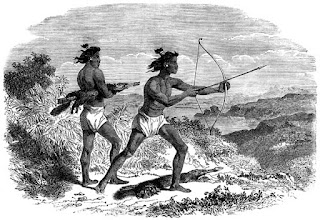As
I've researched information about the founding of the California
missions, I've paid some attention to the natives of the area but
have written very little. In Book Four, I've included an Esselen
Indian as the friend of my Main Character, James Beadle. But, I've
never truly gone deeply into their cultures or beliefs.
I
think it's time to correct that. First, here is a list of the
California Indian Tribes and Organizations from
http://500nations.com/California_Tribes.asp
with a number of links to those tribes who have websites.
In
visiting the various sites, I've come across a common theme –
according to them, the natives lived an ideal life until the coming
of the Spaniards and their soldiers. From then on, they lost their
sparkling cultures and wonderful way of life.
I
don't mean to be cruel or belittling, but these themes appear to be
to gain more concerns and sympathy than to deal with reality.
[The
above depiction is false in that male Indians wore nothing but body
pain and tattoos.]
Indeed,
the weather of coastal California was such that the natives seldom
needed clothing or even substantial structures. They protected
themselves, when necessary, with structures woven together from
branches and sticks. And, if the weather became cold, they donned
furs or capes made from seal hides. As for food, their weak
stone-tipped arrows managed to bring down small animals so they spent
their entire lives foraging for food. Anything went into the small
woven family pot, the liquid heated with stones from the cooking fire
dropped into it, to include, mice, moles, gophers, rabbits, birds
caught in rude nets, and an occasional other animal found wounded or
dead. During periods of bad weather such as droughts, they starved
and many of their children died. And they had plenty of illnesses
that caused death long before the arrival of the Spaniards. For
instance, many suffered from syphilis due to their lifestyle of
seeking sexual partners whenever and wherever possible – they did
not have formal marriages in the European sense.
An
aside. Like most Native Americans, the women were those who selected
their mates. Californians saw the animals around them and understood
the Laws of Natural Selection, the females seeking the best males to
provide for them and their offspring.
An
ideal lifestyle?
The
Chumash were seafarers. They built some truly beautiful boats using
tar found on the beaches to make them seaworthy. They regularly rowed
to the California Channel Islands to hunt for eggs and trap seabirds
living there. But, they had no knowledge of sails and had no defense
against bad weather. Their nets were made of kelp, very heavy and
quite difficult to use to gather in fish.
Very
few natives traveled more than one day's distance from where they
were born. That is why members of the same tribe but different clans
had difficulty speaking with one another.
And
all lived in fear! Unlike other American Indians, they had no
adequate defense against the most fearsome predator in California –
the Grizzly Bear. These creatures roamed at will and readily hunted
and took young children for a meal. Adults could do little about it
as their poorly made bows could not send stone-tipped arrows with
enough force to do anything but annoy the bears.
And,
they had absolutely no knowledge of farming the fertile soil so their
diets lacked many of the nutrients proved by vegetables and fruits.
And, while the land abounded with healthful herbs, the local medicine
men or healers had little knowledge of how to use them.
California,
being a geographical area of instability, had lots of natural hot
springs with healing properties. The natives had some knowledge of
their benefits but did not use them to the fullest. Many tribes
however did use sweat lodges for healing ceremonies.
I'll
discuss more about California Indians in my next post.



